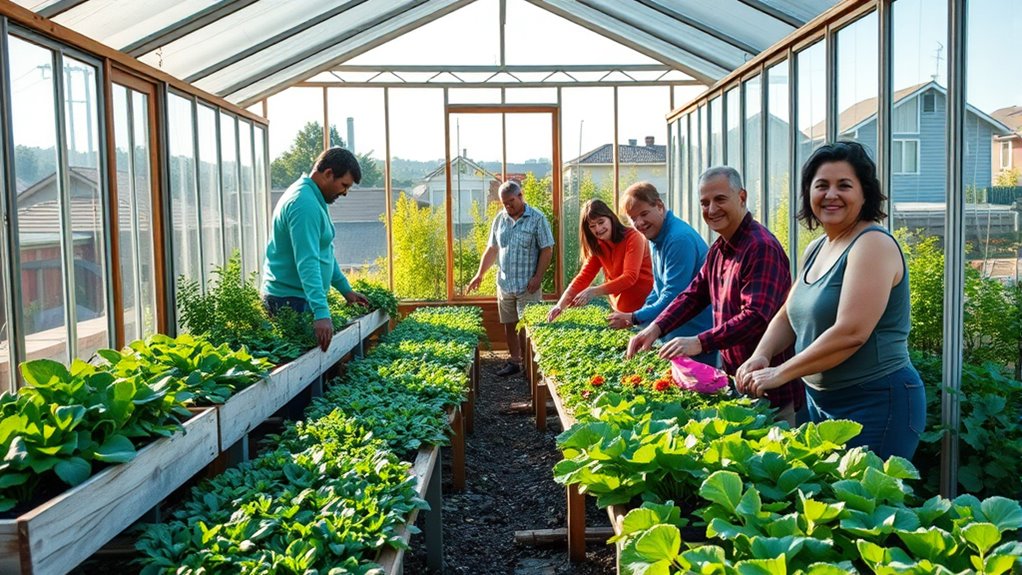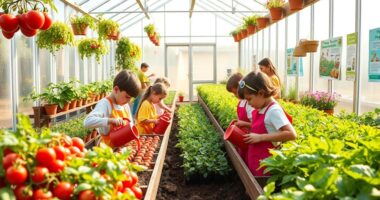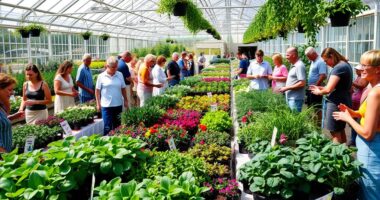Community greenhouses bring neighbors together to grow fresh, healthy food year-round while sharing sustainable practices like composting, water conservation, and eco-friendly gardening methods. By volunteering, you can help plant, tend crops, and organize educational events that foster community bonds. These efforts build local resilience, promote environmental awareness, and turn gardening into a collective effort. If you want to discover more about how community greenhouses nurture both land and community spirit, keep exploring.
Key Takeaways
- Community greenhouses enable neighbors to collaboratively grow fresh produce year-round, fostering shared responsibility and local food security.
- They promote sustainable practices such as composting, water conservation, and energy-efficient lighting to benefit the environment.
- Volunteers can participate in planting, tending, harvesting, and organizing educational events for all ages.
- These spaces build community relationships, encourage eco-conscious habits, and serve as educational hubs for sustainable gardening.
- Long-term, they support community resilience and environmental awareness through collective effort and environmentally friendly methods.

Have you ever wondered how communities grow fresh, healthy produce year-round? Community greenhouses make that possible by bringing neighbors together to cultivate crops regardless of the season. These greenhouses aren’t just about growing food; they’re hubs of sustainable practices that emphasize eco-friendly methods, such as composting, water conservation, and energy-efficient lighting. By focusing on sustainability, community members ensure that their efforts benefit both the environment and their local food systems. Participating in a community greenhouse isn’t just about planting seeds; it’s about committing to responsible practices that reduce waste and minimize ecological footprints. This shared approach to gardening encourages everyone to learn and adopt eco-conscious habits, creating a ripple effect that extends beyond the greenhouse itself. Integrating sustainable gardening techniques helps ensure the longevity of these community efforts and promotes environmental awareness among participants.
Getting involved in a community greenhouse offers numerous volunteer opportunities that cater to a wide range of skills and interests. Whether you’re an experienced gardener or a complete novice, there’s a role for you. You might help prepare the soil, plant seedlings, or tend to the crops as they grow. Others find joy in organizing educational workshops for children or hosting community events that promote healthy eating and sustainability. Volunteer opportunities also include maintenance tasks like watering, pest control, and harvesting, giving you a chance to stay active and engaged. Many greenhouses rely on volunteers to keep operations running smoothly, fostering a sense of ownership and pride among participants. The collaborative environment makes it easy to connect with others who share your passion for food justice, environmental stewardship, or simply making a positive impact in your neighborhood.
Beyond the practical benefits, volunteering at a community greenhouse can be incredibly rewarding. You gain hands-on experience in sustainable gardening practices while building relationships with neighbors and local organizations. As you work together, you develop a stronger sense of community and shared purpose. These greenhouses often serve as educational spaces, empowering residents of all ages to learn about growing their own food and reducing their carbon footprint. By participating, you’re not only helping to produce fresh produce during the colder months but also fostering a culture of sustainability that can inspire others to follow suit. Ultimately, community greenhouses turn gardening into a collective effort, where everyone’s contribution helps nourish both the land and the spirit of togetherness.
Frequently Asked Questions
How Do Community Greenhouses Impact Local Property Values?
You might wonder how community greenhouses impact property values. Generally, they boost neighborhood appeal by adding greenery and fostering community spirit, which can make homes more attractive. This increased appeal often leads to higher property values, as buyers appreciate the enhanced environment and sense of community. So, when greenhouses are well-maintained and integrated, they contribute positively to your property’s worth and the overall charm of your neighborhood.
What Are the Most Common Challenges Faced by Community Greenhouses?
Think of a community greenhouse like a delicate garden maze—challenges can easily trip you up. You often face resource management issues, like balancing water, space, and funding. Volunteer coordination can also be tricky, requiring clear communication and teamwork to keep everything running smoothly. These hurdles test your patience, but with dedication and good planning, you can navigate them and keep the greenhouse thriving for everyone.
How Can Newcomers Join or Start a Community Greenhouse Project?
To join or start a community greenhouse project, you should first engage with local groups to foster community involvement. Reach out to neighbors and potential volunteers to build support. Research funding opportunities through grants or local sponsors to secure necessary resources. Then, collaborate on planning and organizing the project, ensuring everyone’s input is valued. Your active participation can turn a shared vision into a thriving green space for all.
What Are the Environmental Benefits of Community Greenhouses?
Community greenhouses boost urban biodiversity by creating habitats for various plants and pollinators, which helps sustain local ecosystems. They also enhance climate resilience by reducing urban heat islands and lowering energy consumption. When you participate, you’re actively supporting sustainable practices, promoting cleaner air, and conserving resources. These green spaces foster environmental awareness and resilience, making your neighborhood healthier and more vibrant while contributing to broader ecological benefits.
How Do Community Greenhouses Support Food Security?
Think of community greenhouses as lifelines in urban farming, anchoring food security amid city chaos. You can grow fresh produce year-round and participate in seed sharing, which keeps local food sources resilient. These greenhouses empower you and your neighbors to take control of your food supply, reducing dependence on distant markets. By nurturing plants together, you build a sustainable system that feeds your community and strengthens your bonds.
Conclusion
Imagine transforming a small patch of land into a vibrant community hub, where neighbors grow fresh produce together. Did you know that community greenhouses can increase local food production by up to 30%? By working side by side, you not only nourish your bodies but also build stronger bonds. So, why not join your neighbors and turn shared space into a thriving garden? Together, you can cultivate more than just plants—you’ll cultivate community.









